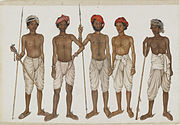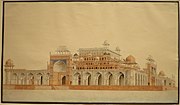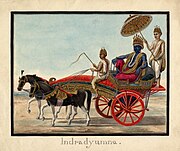Company style
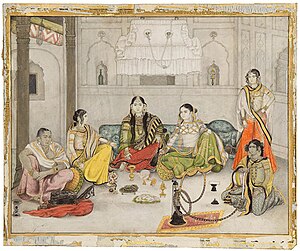
Company style, also known as Company painting
Locations

First emerging in
Portfolios of animal or botanical subjects were also commissioned, and some erotic subjects. Architectural subjects were popular, usually done in a detailed and frontal style more like that of an architectural draftsman than the Romanticised style used by most European painters visiting India. The techniques varied, but mostly drew on Western watercolour technique, from which "transparency of texture, soft tones and modelling in broad strokes" were borrowed.[2]
Patrons and artists
Large-scale patrons included Colonel
The French-born Major-General Claude Martin (1735–1800), latterly based in Lucknow, commissioned 658 paintings of birds, including Black Stork in a Landscape, now in the Metropolitan Museum of Art in New York.[3]
Some notable artists include Mazhar Ali Khan, who worked on Thomas Metcalfe's Delhi Book, and was part of a dynasty of miniature artists, the patriarch of whom, Ghulam Ali Khan, had worked for William Fraser on a similar commission known as the Fraser Album, with over 90 paintings and drawings, mostly painted in 1815 to 1819, which came to light in Fraser's papers only in 1979; they are now dispersed. He, like his uncle Ghulam Murtaza Khan, also painted portraits of the last Mughal emperors and their courts. However, art historians Milfred Archer and Toby Falk, regarding the Fraser Albums, asserted: "Although we can never know for certain who painted each Fraser picture, we can be sure on stylistic grounds that they are the work of a single family, that of Ghulam Ali Khan. Although the finest figure drawings among the Fraser pictures are technically superior to known portraits signed by Ghulam Ali Khan, those of the Gurkhas, the recruits, and some of the single figures such as Kala and Umeechund must be by another member of his family".[4]
The
Material
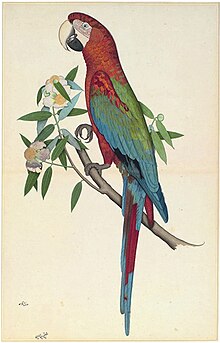
Paintings were mostly on paper, but sometimes on ivory, especially those from Delhi. They were mostly intended to be kept in portfolios or albums; the muraqqa or album was very well established among Indian collectors, though usually including calligraphy as well, as least in Muslim examples. The style developed in the second half of the 18th century, and by the early nineteenth century production was at a considerable level, with many of the cheaper paintings being copied by rote. By the 19th century many artists had shops to sell the work and workshops to produce it.
Decline
The arrival of photography was a direct blow for the style, but it survived into the 20th century, Ishwari Prasad of Patna, who died in 1950, being perhaps the last notable exponent. In the late 19th century the British established several Schools of Art, where a yet more Westernised version of the style was taught, later in competition with other styles.
-
East India Company official and servants, perhaps William Fullerton of Rosemount, surgeon and mayor ofCalcuttain 1757
-
Five Recruits- Ummee Chund, Indur, Goolzaree, Bukhtawur and Juhaz, 1815-16
-
Akbar's Tombat Sikandra, Sheikh Latif, c. 1810-1820
-
Maharaja Ranjit Singh c.1830
-
Indradyumna in a carriage, early 19th century
References
- ^ a b "Company school | Indian art | Britannica". www.britannica.com. Retrieved 29 August 2022.
- ISBN 0-7287-0311-4
- ^ "Black Stork in a Landscape". The Metropolitan Museum of Art, i.e. The Met Museum. Retrieved 25 May 2018.
- JSTOR 23223173– via JSTOR.
- ^ The 'Delhi Book' of Thomas Metcalfe
Further reading
- Archer, Mildred and William G., Indian Painting for the British, 1770–1880 (1955)
- Archer, Mildred. Company Paintings: Indian Paintings of the British Period. London: Victoria and Albert Museum, 1992. ISBN 0944142303.
- Dalrymple, William, Forgotten Masters: Indian Painting for the East India Company, 2019, Philip Wilson Publishers Ltd, ISBN 978-1781301012
- Falk, Toby. (1988). The Fraser Company Drawings. RSA Journal, 137(5389), 27–37. JSTOR 41374777
- Goswamy, B. N. (2011). Masters of the “Company” Portraits. Artibus Asiae. Supplementum, 48, 769–778. JSTOR 23223173
- Kossak , Steven (1997). Indian court painting, 16th-19th century.. New York: The Metropolitan Museum of Art. ISBN 0870997831. (see index: p. 148-152)
- Welch, Stuart Cary. Room for Wonder: Indian Court Painting during the British Period, 1760–1880. Exhibition catalogue. New York: American Federation of Arts, 1978. ISBN 0847801764


